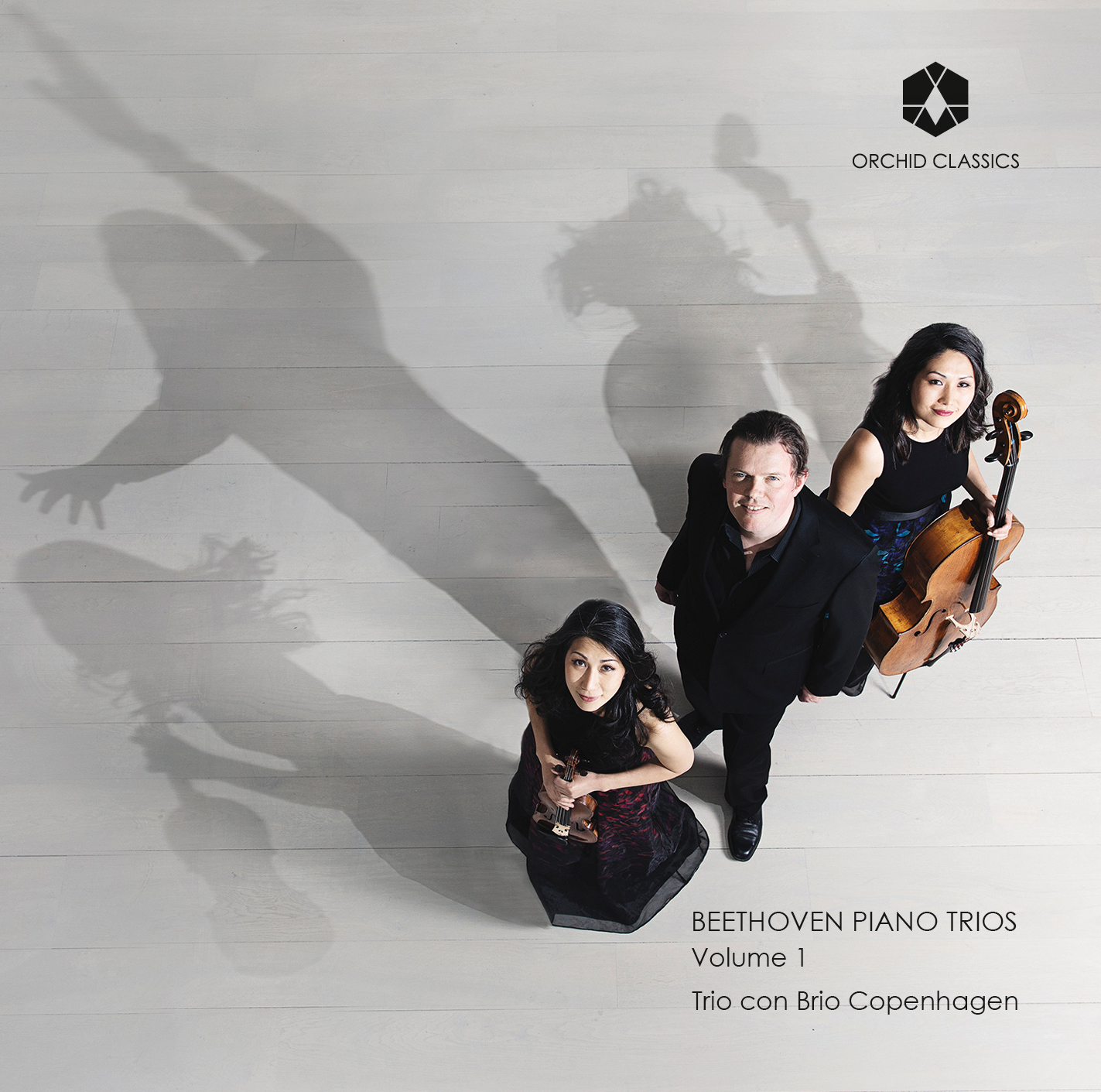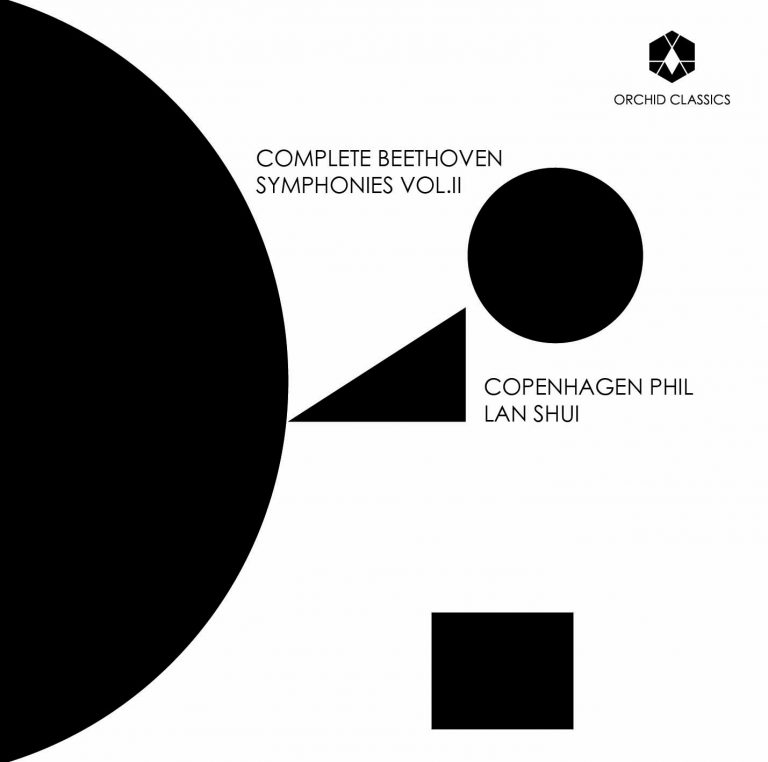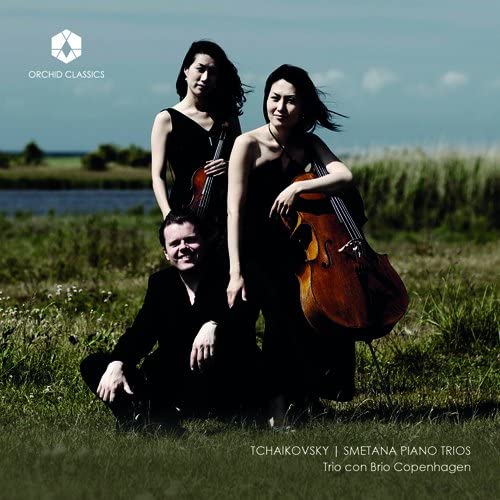Artist Led, Creatively Driven

Beethoven Piano Trios
Volume I
Trio con Brio Copenhagen
Release Date: 4th May 2018
ORC100081
LUDWIG VAN BEETHOVEN (1770-1827)
PIANO TRIOS VOLUME 1
Piano Trio in E flat major Op.1 No.1
1 Allegro 9.40
2 Adagio cantabile 8.23
3 Scherzo. Allegro assai 4.49
4 Finale. Presto 7.13
Piano Trio in D major Op.70 No.1 “Ghost”
5 Allegro vivace e con brio 6.28
6 Largo assai ed espressivo 11.50
7 Presto 7.41
Piano Trio in G major Op.121a, 10 Variations
on “Ich bin der Schneider Kakadu”
8 Introduzione. Adagio assai 5.52
9 Thema. Allegretto 0.40
10 Variation 1 0.41
11 Variation 2 0.41
12 Variation 3 0.47
13 Variation 4 0.41
14 Variation 5 0.43
15 Variation 6 0.38
16 Variation 7 0.53
17 Variation 8 0.39
18 Variation 9 2.13
19 Variation 10 3.24
Piano Trio in B flat major, Allegretto WoO 39
20 Allegretto 5.26
Total time 79.48
Trio con Brio Copenhagen
Soo-Jin Hong, violin
Soo-Kyung Hong, cello
Jens Elvekjaer, piano
The Composer of Extremes
There was revolution in the air when Beethoven, at the age of 21, left his home city of Bonn in autumn 1792 for Vienna, the city of music. In the wake of the Revolution in Paris, French troops invaded the Rhineland, and the court of Electoral Prince Maximilian Franz in Bonn – at which Beethoven had been serving – was in a state of dissolution. Schiller had already written Ode an die Freude, in which he advocated a fraternity that transcended hierarchies, and at the piano the young Beethoven displayed an ‘almost inexhaustible profusion of ideas’, according to one of his music colleagues in Bonn.
With his departure for Vienna, Beethoven became a free man, and it marked an end to an existence as a musician in the brilliant red uniform of the electoral prince. Most important for Beethoven now was to catch people’s attention as an artist, and this he did with his three Piano Trios Op.1, which were published in 1795. A Viennese newspaper wrote the following: ‘Beethoven emerges as a formidable, powerful and arresting piano composer in these beautiful trios,’ which call for an ‘accomplished pianist’. With his virtuoso skills, Beethoven was just the man to play the piano part in the trios, and this gave him an opportunity to capture the attention of those who frequented the aristocratic salons of Vienna.
The violin and cello are, however, no longer mere accompanists of the virtuoso excursions of the piano, as was often the case in the piano trios of earlier periods. The three instruments are three equal partners, and the violinist and cellist also get an opportunity to display their talents. But in Piano Trio in E flat major Op.1 No.1, which was composed in 1793, during Beethoven’s first year in Vienna, there can be no doubt that Beethoven intended his own instrument to have the main role. An untamed, explosive energy characterises the piano part, and after all three instruments have burst open the door to the musical arena with the first powerful chord, it is symbolically the piano that with the following ascending triad sends the music skywards. And when, towards the conclusion of the first movement, the pianist sets out on a finger-breaking solo run, the two string instruments fall silent, and subsequently they acclaim the piano hero with repeated notes that mostly remind one of enthusiastic applause!
During the large-scale first movement itself, the three instruments often join forces and the created orchestral effects presage the symphonies that are soon to follow. And even though Beethoven is here within the tradition of Viennese classical music, his surprising alternation between fortissimo and pianissimo goes beyond the convention of the time. We are not just dealing here with ordinary indications of dynamics. The music is being made an exponent of autonomous human emotions – Beethoven’s revolutionary mind had many facets.
In the second movement, marked Adagio cantabile, where Beethoven begins by letting the piano sing a demure and delectable melody, the young composer shows himself to be a dreaming bel esprit. The three instruments almost blend into a single voice in this inspired, gentle movement that brims over with natural feeling, completely in accordance with the pantheism of the time and the idea that everything is infused with a divine power.
Beethoven was a composer of extremes, and in the rapid Finale he shows himself from his provocative side. With the initial repeated piano figures it is as if Beethoven allows a street urchin to whistle and, what is more, with tension-laden pauses in between. Here anything can happen. At one moment, all three instruments charge off at a brisk pace. At the next moment, Beethoven allows the music to shrink, so that it becomes a mere shadow of itself. And if there are signs of approaching moments of beauty, they are immediately sabotaged by a gleefully coarse-grained music.
Beethoven’s ability to make musical grimaces was quite extraordinary, and here we see him at his most frisky. Like a musical counterpart to the sculptor Franz Xaver Messerschmidt, who with his highly original ‘character heads’ had attempted in vain to make a name for himself in Vienna. He was unsuccessful and was characterised as ‘mad’. The same was going to be said of parts of Beethoven’s late music, but by then his genius had long since made him an ineluctable part of Viennese culture.
When Beethoven once more began composing piano trios in 1808 – two trios with the opus number 70 – we find ourselves in Beethoven’s so-called ‘heroic period’. With epoch-making works such as Symphony No. 3 (Eroica) and Symphony No. 5 he sets the agenda in the world of music. At the same time, Beethoven experiences the personal tragedy of increasing deafness. ‘I live a miserable life,’ he writes, referring to the fact that as a musician he has to attempt to conceal his fatal handicap.
Beethoven’s ability to turn music into drama is abundantly clear with the opening of the Piano Trio in D major Op.70 No.1 “Ghost”. All three instruments storm forward in a unison musical formation that can rival Napoleon’s advances on the battlefield.
But after five bars there is a change of scene. The Blitzkrieg suddenly ends and, with the cello as protagonist, a transformation takes place. From having acted as an aggressor at one moment, the cello part now sings with a porous human voice – dolce – and the other instruments soon join it. Beethoven as a humanist who was able to focus sharply on the extremes of his age.
In the second movement, marked Largo assai ed espressivo, which has given rise to the name by which the trio is most often known “Ghost”, we delve even deeper, right into the human mind. A subdued, plaintive melody, first heard in the piano, returns repeatedly like a memento of grief. And with whispering trills in the lowest notes and plunging falls over the entire musical register Beethoven creates theatrical music for an inner stage. In the sketches for the Largo we find drafts of a never-realised opera based on Shakespeare’s Macbeth, and with an inlaid witches’ chorus. It was the composer Carl Czerny, however, who a number of years after Beethoven’s death gave the trio the nickname “Ghost”, because he associated it with the scene from Hamlet where the prince’s dead father shows himself as a spirit.
The concluding Presto is typified by a predominantly light and carefree musical idiom, but it is a changed ego that has emerged into the light after the dark Largo.
The music comes to a halt after only four bars, trapped in a musical blind alley after a surprising modulation. After this, it continues unconcernedly, but with a number of further abrupt stops – it is like following a shocked person who is no longer able to find the usual way home. The Beethoven biographer Adolf Bernhard Max referred in 1859 to the Trio Op.70 No.1 as a ‘soul image’ (Seelenbild). The way was paved for Freud, who several decades later was to explore the subconscious.
Piano Trio in G major Op.121a, 10 Variations on “Ich bin der Schneider Kakadu”, is an enigmatic work. Here the ageing Beethoven casts a look back at the music of his youth. In doing so, in a protracted introduction that is to be played Adagio assai and that starts with a series of sudden fateful blows, a sombre ascending minor theme can be heard. It later transpires that this is a melancholy version of the popular tailor theme from the now-forgotten opera Die Schwestern von Prag, which is the point of departure for the virtuoso and predominantly cheerful variations. The introduction was composed very late in Beethoven’s life, possibly in 1824, when the Trio was published, but the main part of the variations would seem to have been composed about 20 years earlier.
We are dealing here with a musical double image, and Beethoven does not seek to integrate the two musical worlds. Rather the opposite. The darkly coloured introduction casts shadows over the subsequent naive youthful music. In the final variation, however, Beethoven lifts the work up into a different sphere. With an imposing double fugue on the minor version of the theme we become part of a greatness also familiar from Symphony No.9. Here Beethoven uses the form of the fugue to lead us on to the great brotherhood of man, with Schiller’s words ‘Alle Menschen werden Brüder’.
Piano Trio in B flat major, Allegretto WoO 39 from 1812 shows us a Beethoven from an utterly innocent side, with a rocking time and charming melodies that present themselves without any musical sticking points en route. The explanation is simple: the piece was written so as to be able to be played by the 10-year-old Maximilian Brentano. Beethoven takes trouble here to show himself at his most innocent and lovable. Perhaps because Maximilian’s mother, Anthonie Brentano, was in all probability the woman whom Beethoven that same year described in a love-letter as his ‘Unsterbliche Geliebte’, his immortal beloved.
© Trio con Brio Copenhagen and Esben Tange
Trio con Brio Copenhagen
“Glowing reports hold true. The Trio con Brio Copenhagen clearly occupies a lofty perch in today’s musical scene.”
Washington Post
“From the first note, Trio con Brio exudes class … both explosive and exquisitely intimate – aspects that this performance delivers with compelling panache.”
Strad
Founded in Vienna in 1999 with the concept of pairs coming together, the two Korean sisters, and Soo-Kyung and Jens (who are now married), have since then been exploring the piano trio repertoire with freshness and curiosity as well as with respect and reflection. In particular they have been gaining a reputation for the freshness of their approach to the core repertoire: “works by Beethoven, Schubert and Brahms are transformed in their hands into the alive-and-kicking music of today” – Esben Tange, editor at DR P2.
Since its inception the Trio has won most of the international competitions for piano trio, including the ARD (Munich), Vittorio Gui (Florence) and Norway’s Trondheim Competition. In January 2015 the Trio became the first ensemble to receive one of Denmark’s most prestigious music awards, the “P2 Artists Prize,” at a live televised concert where they performed Beethoven’s Triple Concerto with the Danish National Symphony Orchestra. Other major awards received include the Kalichstein-Laredo-Robinson International Trio Award (USA) and the “Allianz Prize” in Germany’s Festspiele Mecklenburg-Vorpommern.
Trio con Brio Copenhagen is in great international demand and has an intensive worldwide touring schedule. Recent and future appearances include Washington DC, New York City, Los Angeles, Seoul, London, Hamburg, Heidelberg, Paris, Stockholm, Oslo and Copenhagen among many other cities. In recent years, Trio con Brio Copenhagen has appeared in major concert halls in Europe, the USA and Asia, such as Tivoli Concert Hall, Concertgebouw, Carnegie Hall, Lincoln Center, Wigmore Hall, Elbphilharmonie Hamburg, Konzerthaus Berlin, Louvre Paris, Théâtre de la Ville Paris, Seoul Arts Center, Bunka Kaikan Tokyo, and Teatro Olimpico Vicenza.
Trio con Brio Copenhagen continues to play a central role in Scandinavia’s vibrant contemporary music scene. Several of Denmark’s most prominent composers including Per Nørgård and Bent Sørensen, as well as Swedish composer Sven-David Sandström, have composed and dedicated works to the Trio. Trio con Brio Copenhagen was enormously honoured to be chosen by Per Nørgård to be the dedicatee of a work that was premiered at a festival in Stockholm celebrating his 80th birthday in 2012. In January 2016 the trio presented the world premiere of Bent Sørensen’s Triple Concerto with the Danish National Orchestra for which Bent Sørensen was awarded the prestigious Grawemeyer Award in 2017.
The Trio’s recordings have been praised by critics. American Record Guide wrote: “One of the greatest performances of chamber music I’ve ever encountered …”. Gramophone Magazine wrote: “… Any
group would be hard-pressed to imitate this blend of verve and poise …”. Their Mendelssohn CD was chosen by Classic FM, UK as Chamber Disc of 2011: “Every phrase soars and pulsates with the excitement of a fresh discovery as the Copenhagen players go the full distance with playing of skin-rippling sensitivity… sensational playing…”. Their latest recording of trios by Tchaikovsky and Smetana was hailed by The Guardian (UK): “… Trio con Brio Copenhagen scale the Tchaikovsky’s heights with the verve their name suggests …”
Trio con Brio Copenhagen is frequently featured as soloists in Beethoven’s Triple Concerto with orchestras. In 2011 the Trio premiered a new Triple Concerto by the renowned Swedish composer Sven-David Sandström with the Danish National Symphony Orchestra and Kristjan Järvi in Copenhagen’s Koncerthuset. The following year, they were invited to perform the Triple Concerto with the Stockholm Philharmonic Orchestra for Sandström’s 70th birthday concert in the Stockholm Konserthus.
The Trio is artistic director of the Copenhagen Chamber Music Festival, the Chamber Music Festival on Lundsgaard Estate in Kerteminde and the Hellerup Chamber Music Society in Copenhagen.
The Trio’s sound benefits from the superb instruments they play: Soo-Jin plays a violin built by Andrea Guarneri from the 17th century, Soo-Kyung plays a Grancino cello, and Jens is Denmark’s first Steinway Artist. Both string players are endorsed by Jagar Strings and Thomastik-Infeld Vienna.
The ensemble was coached by the Alban Berg Quartet, Frans Helmerson, Mihaela Martin and Harald Schoneweg at the Cologne University of Music and received excellent musical guidance by Ferenc Rados in Budapest.
More information is available on Trio con Brio Copenhagen’s website: www.trioconbrio.dk









